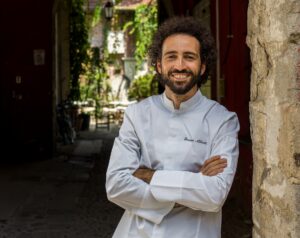Centuries of recipes, happy culinary accidents and a lot of passion: the history of traditional French desserts goes through many steps that are enriched with interesting and often curious stories.
If the first cake was produced in Greece more than 7,000 years ago, the so-called obélias (which meant offering because it was used within rites sacred to Greek gods) was a mixture of flour and honey cooked on a heated stone, we will have to wait until the Middle Ages in France to talk about the first cake by the chef like Guillaume Tirel, author of the famous cooking manuscript called Le Viandier.
Instead, ice cream arrived in the 16th century, with the marriage of Catherine de Medici and the future Henry II, as well as the choux pastry invented by Popelini, famous Italian pastry chef arrived at the French court with Catherine. It was also during this period that the first confectioners' guild, while in the 17th century Anne of Austria brought chocolate from the Spanish court. I buffet of the court of Versailles are adorned with multi-story cakes, and invented by François Vatel is the Chantilly cream, that is, whipped cream.
In the first half of the 19th century, directly from Austria come to enrich the le viennoiseries french patisserie, cakes with bread-like baking such as the croissant.
A twinning between Austria and France in pastry making that was as fortuitous as it was effective. Indeed, it is owed to the Austrian officer on leave. August Zang, who opened in Paris on Rue de Richelieu his patisserie of typical viennese sweets, being imitated by many French bakers.
The most obvious development of the French pastry occurred mainly in the 19th century, thanks in part to Marie Antoine Carême. It was he, in fact, who codified a style of cooking in his work "The Royal Confectioner", still a landmark for connoisseurs in the field, and it is also to him that we owe, for example, the introduction of the five-round puff pastry dough into the pastry industry.
Famous for its croquembouche and others pièce montée, some of them truly grand, over a meter high, made entirely of sugar, marzipan and pastry products, is remembered for its reproductions of temples, pyramids, ancient ruins and other architectural structures.
His cakes and pastry creations, sometimes true works of art, were commissioned and appreciated by French diplomat and gourmand Charles Maurice de Talleyrand-Périgord and by the Napoleon Bonaparte.
The 10 most famous French desserts in the world
French Patisserie is now famous all over the world, but surely there are at least 10 French desserts that, more than any other, have marked everyone's imagination.
And they are:
- La tarte tatin: fruit of the activity of sisters Caroline and Stéphanie Tatin who, while preparing an apple pie in their restaurant, forget it in the oven, thus causing it to burn. They decide to save the caramelized apples and pour pastry over them.
- La religieuse: was invented in 1855 by Frascati, a famous Parisian pastry chef-ice cream maker. At first it was in the form of a square of choux pastry filled with custard and topped with whipped cream.
- Paris-Brest: prepared in honor of the 1905 Paris-Brest bicycle race, it is a cake made of buttercream, praline almonds and choux pastry and is shaped like a bicycle wheel.
- The éclair: very famous now and there are of today's truly artistic ones.
- The millefeuille
- The macaron
- La Saint-Honoré
- L'Opéra
- Lemon meringue pie
- La fraisier: strawberry, cream and sponge cake.
Italian Food Academy's specialization course in French Sweets.
Do you want to learn the techniques and recipes of traditional pastry making From beyond the Alps? Italian Food Academy organizes a French Sweets Specialization Course: a full-immersion training experience that will teach you how to prepare small delights of high French pastry.

The course syllabus covers the following topics:
- History of French pastry
- Tools and equipment
- Preparation techniques
- Eclair
- Tarte tatin
- Tarte au citron meringuee
- Vacherin
- Savarin au rum
- Molleux au chocolat
- Macarones
- Madeleines
- Profiteroles
- Modern Entremet
- Fruit Parfait
- Fruit coulis and crunchy waffles
- Fruit and chocolate mousse
- Tarte brûlée








